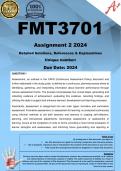Exam (elaborations)
FMT3701 Assignment 2 (COMPLETE ANSWERS) 2024 - DUE June 2024
- Course
- Institution
- Book
FMT3701 Assignment 2 (COMPLETE ANSWERS) 2024 - DUE June 2024 ; 100% TRUSTED workings, explanations and solutions. for assistance Whats-App 0.6.7..1.7.1..1.7.3.9 ............. QUESTION 1: (5) Explain the concept, ‘assessment’, as outlined in the CAPS document and your study guide. QUESTION ...
[Show more]




